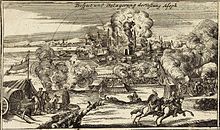Rodion Nikolaevich Harbel
Rodion Nikolayevich Härbel , born Rudolf Härbel , ( Russian Родион Николаевич Гербель * 1716 in Switzerland ; † December 3 . Jul / 14. December 1780 greg. In Kolositsa, Ujesd Jamburg ) was a Russian engineer-General .
Life
Härbels father Nicolaus Friedrich Härbel came in August 1719 with his wife, daughters Catherine (* 1710) and Christina (* 1714) and his son Rudolf from Basel to St. Petersburg and was in the new capital quickly a successful architect who finally in was incorporated into the Russian nobility . The son Rudolf, now Rodion, was accepted into the engineering corps at the age of fifteen .
During the Russo-Turkish War (1736-1739) Harbel took part in 1736 in the siege of the Azov fortress . 1737 he became adjutant of Lieutenant General Ulrich von Löwendal with which he the storming of the fortress in the summer of 1737 Ochakov mitmachte. In 1738 he was poruchik in Riga 11th Dragoon - Regiment , with whom he Field Marshal Burkhard Christoph von Munnich at the battle at Stawutschani and the siege of Khotin participated.
In 1739 Härbel returned to the engineering corps. During the Russo-Swedish War (1741-1743) he was sent in 1742 as Kapitan-Porutschik to the embassy at the congress in Åbo and then to Stockholm to conclude peace .
In 1750 Härbel was promoted to captain and in 1755 to major in the Russian army. During the Seven Years' War he took part in the battles near Groß-Jägersdorf , Zorndorf , Palzig and Kunersdorf , in the sieges and earnings of Memel , Küstrin and Kolberg as well as in the occupations of Königsberg and Berlin . After conquering the Pillau fortress in January 1758, Härbel was promoted to Podpolkownik. In 1759 he blocked the Friedrichsgraben by blowing up the lock , for which he was promoted to Polkownik . In 1762 he introduced a state of war in the fortresses in Finland , for which he became major general and received the Order of Saint Anne . After the end of the war in 1763, he was assigned to the port of Narva and then returned to St. Petersburg.
In 1766 Härbel became an engineer general and head of the engineering corps. During the Russo-Turkish War (1768–1774) he was assigned to Count Pyotr Ivanovich Panin's 2nd Army in 1770 , which was to besiege the Bender fortress . He developed the siege plan and personally supervised all work. Thanks to his trench system and the cleverly arranged demolitions, the fortress could be taken after 8 weeks, whereupon he was promoted to General Porutschik and received the Alexander Nevsky Order .
In 1772, Harbel was mainly concerned with securing the capital St. Petersburg with a defense system between Villmanstrand and Fredrikshamn . In 1774 he was dismissed from service for health reasons. He received the Kolositsa estate (Ujesd Jamburg) with 700 farmers. His sons Gustav and Vasili also served in the army.
Individual evidence
- ↑ a b c d e f g h i Гербель, Родион (Рудольф) Николаевич . In: Русский биографический словарь . tape 4 , 1914, pp. 493-494 ( Wikisource [accessed November 25, 2017]).
- ↑ a b Гербель - русский дворянский род . In: Brockhaus-Efron . tape VIII , 1892, p. 453 ( Wikisource [accessed December 2, 2017]).
- ↑ Л. Фриман: История крепости в России . St. Petersburg 1895, p. 147-149 .
| personal data | |
|---|---|
| SURNAME | Harbel, Rodion Nikolayevich |
| ALTERNATIVE NAMES | Härbel, Rudolf (birth name); Гербель, Родион Николаевич (Russian) |
| BRIEF DESCRIPTION | Russian engineer general |
| DATE OF BIRTH | 1716 |
| PLACE OF BIRTH | Switzerland |
| DATE OF DEATH | December 14, 1780 |
| Place of death | Kolositsa, Ujesd Jamburg |

